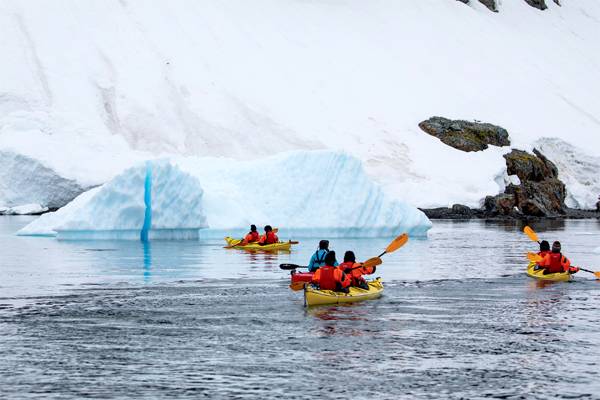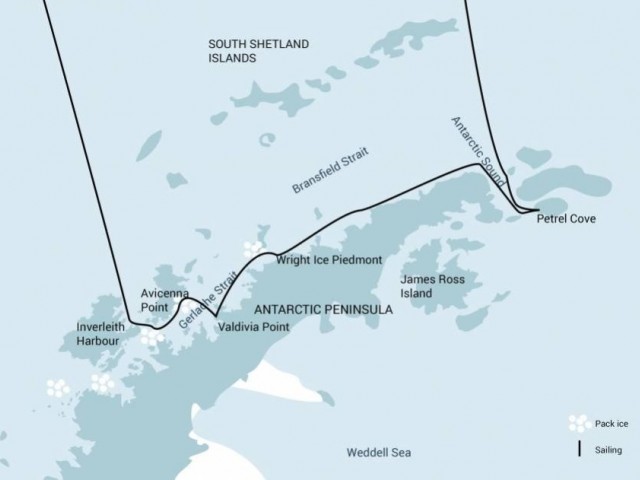HIGHLIGHTS
- Embark
on your journey from Ushuaia, Argentina which is reputed to be the
southernmost city on the planet, located on the far southern tip of
South America
- Launch
from the small resort town on Tierra del Fuego, nicknamed The End of
the World
- Sail
the mountain-fringed Beagle Channel
- Sail
across the Drake Passage and enjoy some of the same experiences
encountered by the great polar explorers who first charted these regions
- Passing
the Antarctic Convergence which is the natural boundary formed when
north-flowing cold waters collide with warmer sub-Antarctic seas
- Notice
how the marine life and the avian life changes from this point
- Watch
wandering albatrosses, grey-headed albatrosses, black-browed
albatrosses, light-mantled sooty albatrosses, cape pigeons, southern
fulmars, Wilson’s storm petrels, blue petrels, and Antarctic
petrels
DATES / RATES
Rates are listed per person in USD. Promotional offers are not reflected in the rates below.
|
| Start Date | End Date | QUAD | TRIPLE | TWIN PORTHOLE | TWIN WINDOW | TWIN DELUXE | SUPERIOR |
|---|
Rates are listed per person in USD. Promotional offers are not reflected in the rates below.
|
| Start Date | End Date | (Starting from)
QUAD | (Mid-range)
TWIN WINDOW | (High-end)
SUPERIOR |
|---|
ITINERARY
Day
1: End of the world, start of a journey
Your
voyage begins where the world drops off. Ushuaia, Argentina, reputed to
be the southernmost city on the planet, is located on the far southern
tip of South America. Starting in the afternoon, you embark from this
small resort town on Tierra del Fuego, nicknamed “The End of
the World,” and sail the mountain-fringed Beagle Channel for
the remainder of the evening.
Day
2-3: Path of the polar explorers
Over
the next two days on the Drake Passage, you enjoy some of the same
experiences encountered by the great polar explorers who first charted
these regions: cool salt breezes, rolling seas, maybe even a fin whale
spouting up sea spray. After passing the Antarctic Convergence
– Antarctica’s natural boundary, formed when
north-flowing cold waters collide with warmer sub-Antarctic seas
– you are in the circum-Antarctic upwelling zone. Not only
does the marine life change, the avian life changes too. Wandering
albatrosses, grey-headed albatrosses, black-browed albatrosses,
light-mantled sooty albatrosses, cape pigeons, southern fulmars,
Wilson’s storm petrels, blue petrels, and Antarctic petrels
are a few of the birds you might see.
Day
4: Icescapes of the Antarctic Sound
Glaciers,
icebergs, and pack ice extend into the horizon. On the northern side of
the Antarctic Sound is Dundee Island, where you have the chance to land
at Petrel Cove. The Argentinean Base Petrel is located here, and its
massive airplane hangar hints at the base’s heritage: It was
from this stretch of flat land that Lincoln Elsworth and Herbert
Hollick-Kenyon completed the first flight across the Antarctic
Continent in 1935. In the Antarctic autumn, a large number of Antarctic
fur seals and southern elephant seals haul up on the beaches here.
Alternatively, you may explore Active Sound if ice conditions allow.
Day
5: Sailing the Wright Ice Piedmont
Next
you sail along the Wright Ice Piedmont at Graham Land, which was mapped
based on photographs taken between 1955-1957. The piedmont was named
after the brothers Wilbur and Orville Wright, who in December 1903 were
the first people to fly an airplane.
Day
6: Valdivia Point views
Keeping
to the west coast of Graham Land, you reach Valdivia Point, named after
the German ship Valdivia by Otto Nordenskjöld’s
Swedish Antarctic Expedition. Further west you may also see Challenger
Island and Bluff Island.
Day
7: The bays of Brabant Island
You
then continue sailing to the western side of Brabant Island, exploring
Avicenna Bay, Buls Bay, and the analysis-inspiring Freud Passage.
Day
8: Anvers Island adventure
At
the northeast coast of Anvers Island, you next visit Fournier Bay. This
location was probably first sighted by a German expedition under the
command of Eduard Dallmann in 1873-1874, chartered by the French
Antarctic Expedition of Jean-Baptiste Charcot (1903-1905). It was named
after the French admiral Ernest Fournier. You might also make a landing
at Inverleith Harbor (also on the northeast coast of Anvers), possibly
spotting an Antarctic tern colony as well as Weddell seals.
Day
9-10: Familiar seas, familiar friends
Your
return voyage is far from lonely. While crossing the Drake,
you’re again greeted by the vast array of seabirds remembered
from the passage south. But they seem a little more familiar to you
now, and you to them.
Day
11: There and back again
Every
adventure, no matter how grand, must eventually come to an end.
It’s now time to disembark in Ushuaia, but with memories that
will accompany you wherever your next adventure lies.
 (Click image to view Ship details)
(Click image to view Ship details)
WHAT'S INCLUDED
- Voyage
aboard the indicated vessel as indicated in the itinerary
- All
meals throughout the voyage aboard the ship including snacks, coffee
and tea
- All
shore excursions and activities throughout the voyage by Zodiac
- Program
of lectures by noted naturalists and leadership by experienced
expedition staff
- Free
use of rubber boots and snowshoes
- Luggage
transfer from pick-up point to the vessel on the day of embarkation, in
Ushuaia.
- Pre-scheduled
group transfer from the vessel to the airport in Ushuaia (directly
after disembarkation)
- All
miscellaneous service taxes and port charges throughout the program
- Comprehensive
pre-departure material
ADVENTURE
OPTIONS
- Kayaking:
FREE
- Camping:
FREE




